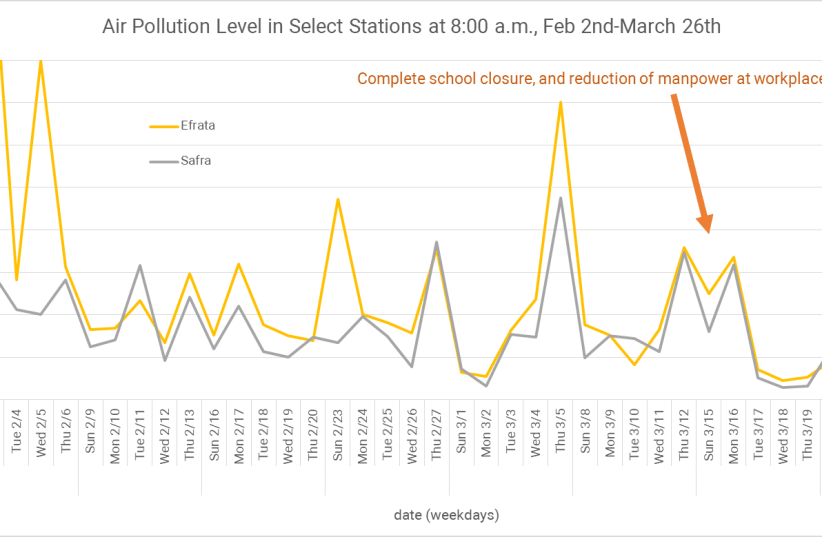Air quality is measured and published continuously by the Ministry of Environmental Protection’s air monitoring system, which operates a large number of monitoring stations. We checked a few stations in Jerusalem, and examined the nitrogen oxides (NOx) rate in the air. This pollutant is emitted by fuel burn and may be affected by the reduction in car travel. The pollutant is measured in parts per billion – micrograms of nitric oxide per cubic meter, multiplied by a coefficient of station height above sea level, affect- ing air density.
The peak hour in NOx pollution is generally at 8 a.m., when people travel to work, and on normal days, children are on their way to school. We checked the pollution level at 8 a.m. every weekday (excluding Saturday and Friday), starting in early February until March 29.
At the stations located in Safra Square and the Baka neighborhood (Efrata College), it seems that until March 16, pollution levels were normal, with the weekly average (of the 8 a.m. level on weekdays) ranging roughly between 15 to 20 ppm. On March 15, guidelines were issued regarding the closure of all educational institutions and a significant reduction in manpower in the workplace. After March 17, pollution levels at both of these stations dropped significantly, not exceeding 15 ppm, and most days were below 10 ppm.
Two of the stations located near major transport routes, Bar Ilan (near the Sanhedria junction) and Devorah Haneviah (near Hane- vi’im St.), are characterized by higher pollution levels, but there, too, except on Sunday, March 22, the levels dropped to about half of what they were before.
It is interesting to note that when comparing pollution level patterns over the day, there was no major change in the Safra and Efrata stations, and both were characterized by the same pattern before and after the new guidelines. This includes a peak at 7 a.m. to 8 a.m., and another peak (sometimes higher than the morning), around 8 p.m. to 10 p.m. It is surprising to see that even without the regulation regarding school hours and with major travel cuts, the morning routine, for those who still have it, adheres to the same times. Even though the amounts were significantly lower, the patterns remained the same.
It is good to know that the new situation also has positive consequences. Stay home, but feel free to open the windows.
